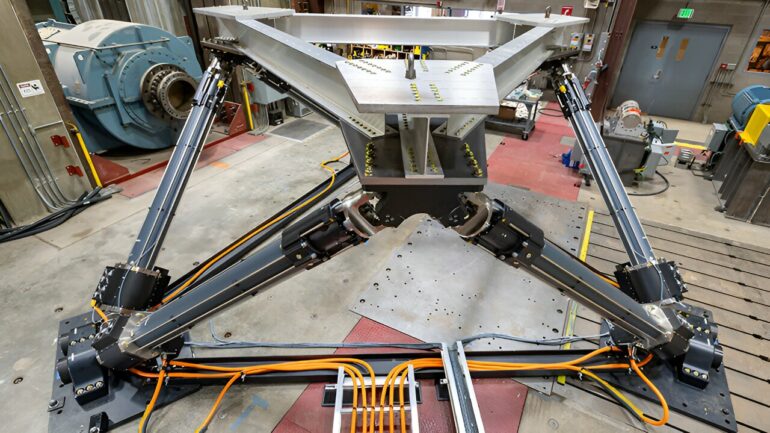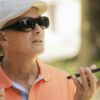Before pilots take to the real skies, they must first master the virtual ones. Luckily, there is a capability for that: A flight simulator replicates air flight—with all its choppy weather and turbulence—so pilots can practice on safe, solid ground.
Researchers at the National Renewable Energy Laboratory (NREL) recently installed a technology that can replicate another choppy and turbulent environment: the ocean. The laboratory’s new large-amplitude motion platform—known as LAMP for short—is like a flight simulator for offshore energy technologies. With LAMP, researchers can learn how wave energy devices, as well as offshore wind turbines and floating solar panels, might fare out on the ocean—all from the safety of landlocked Colorado.
“LAMP can move ocean devices in the way they would move in the ocean, bobbing up and down in the waves,” said Rebecca Fao, a research engineer in NREL’s water power technology group.
Open-ocean trials are a critical step in an offshore technology’s journey from concept to commercialization. But trials can be expensive, time consuming, and risky. If the weather shifts or a part malfunctions, technology developers can lose precious time (and money) sending boats and divers out to rescue the device from extreme waves or to repair damage.
But NREL’s LAMP, which was installed in June 2023 with support from the U.S. Department of Energy’s Water Power Technologies Office, can help developers identify potential flaws before they take that risky ocean plunge.
The LAMP was made by E2M in the Netherlands and looks a bit like a lunar module with its broad, multilegged platform. The technology can be used either indoors or outdoors and supports devices that weigh up to 2,200 pounds (about as much as a small recreational vehicle). With an offshore device mounted on top, the LAMP mimics ocean movements in six degrees of freedom—meaning it can move in six directions like surges and swirling rolls in the ocean—and vigorous ocean waves up to 8 feet tall. And the technology can shift all those motions in real time to accurately mimic data pulled from actual ocean sites.
“Before LAMP, we traditionally did dry testing on dynamometers,” Fao said.
Dynamometers sound like hefty, dino-like machines—and they are. Technology developers can hook up a piece of their device, like the generator, and subject it to ocean-like forces, testing to see how well it operates or even how long it can endure.
But researchers cannot test every single piece of a device with just dynamometers, and LAMP is a better ocean imitator anyway.
NREL has yet another ocean replicator: a wave tank. But that tool is designed for smaller prototypes. With the LAMP, researchers can put large and even full-scale devices to the test. Plus, the platform has a few tricks up its actuators: It can mimic a wave tank—a kind of imitation of an imitation—using software to replicate the tank’s waves.
But the LAMP’s biggest boon is its size.
“We hope to bridge that gap from small tank to ocean using LAMP,” said Dale “Scott” Jenne, a mechanical engineer in NREL’s water power group. Jenne will be one of the first to use the LAMP to validate his team’s wave energy converter, which can turn ocean water into clean drinking water.
Rick Driscoll, a senior engineer at NREL, has been working to acquire a motion platform for the lab for almost a decade. Once marine energy developers progressed enough to build their first small prototypes, he said there was a “clear need to test such systems in a controlled environment prior to ocean deployment.”
Now, with the LAMP, wave tank, and dynamometers, NREL’s facilities can more than fill that need. If a prototype can survive the LAMP, it is far more likely to succeed at sea. And if it cannot, the developer can learn how to improve their design and build a better, more durable version before heading out to sea.
“LAMP will allow for a more complete approach to design iteration,” Fao said. “It’s going to give researchers the ability to fine-tune aspects of their technology, but in a holistic, low-risk way.”
Provided by
National Renewable Energy Laboratory
Citation:
New water-free large-amplitude motion platform can imitate ocean waves (2023, August 10)



